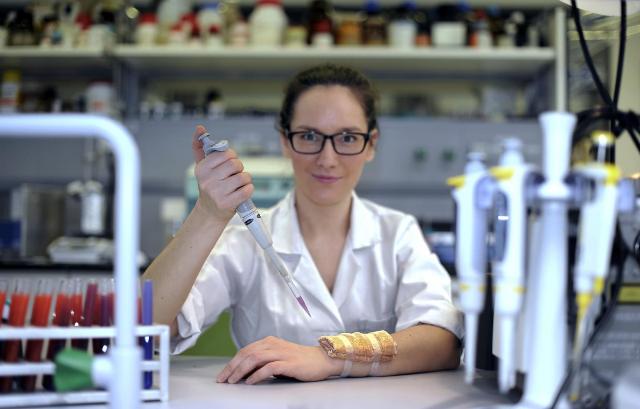Feb 23 2015
Ruthless with bacteria, harmless to human cells. New, durable antibacterial coatings of nanocomposites, developed at the Institute of Physical Chemistry of the Polish Academy of Sciences in Warsaw, will in future help to improve the hygiene of sportswear, and used in medicine, will reduce the rate of infections and shorten the times of in-patient hospital admissions.
 An antibacterial dressing with gold nanocomposites being presented by Dr. Katarzyna Wybrañska from the Institute of Physical Chemistry of the Polish Academy of Sciences (IPC PAS) in Warsaw, Poland. (Source: IPC PAS, Grzegorz Krzy¿ewski)
An antibacterial dressing with gold nanocomposites being presented by Dr. Katarzyna Wybrañska from the Institute of Physical Chemistry of the Polish Academy of Sciences (IPC PAS) in Warsaw, Poland. (Source: IPC PAS, Grzegorz Krzy¿ewski)
How do you speed up wound healing? How do you shorten the minimum in-patient stay in hospital and cut down the associated cost? Here's one answer: dressings with antibacterial coatings, developed at the Institute of Physical Chemistry of the Polish Academy of Sciences (IPC PAS) in Warsaw. The new method of producing nanocomposite antibacterial coatings is universal and can be used to modify the surfaces of various materials. After modification, the materials exhibit excellent antiseptic properties, whilst remaining very friendly to human cells. The coatings' usefulness is not limited to the field of medicine: they can be used, for example, to improve the level of hygiene of everyday items of clothing such as socks, insoles, sports underwear, etc., as well as in the production of sportswear. Their mass use is favoured by the fact that the nanocomposite coatings from the IPC PAS arise in a fast and cost-effective process.
The new antibacterial coatings are prepared in solutions of boron compounds containing colloidal nanoparticles of gold. After the introduction of the agent causing polymerization, gold nanocomposites are deposited on the surface of the object immersed in the colloid within a dozen or so minutes. The linking with the substrate is of a chemical nature, so it is considerably stable. Depending on the amount of deposited nanocomposite, the modified materials can vary in colour from light pink, through violet, to dark navy.
Although gold is not the cheapest of materials, its nanocomposite coatings are stable and do not undergo degradation during laundering in detergents. Repeated laboratory tests of the antiseptic properties of the new coatings have been carried out with, among others, E. coli and Staph. aureus, i.e. both Gram-negative and Gram-positive bacteria. Tests have shown that after 12 hours the number of bacteria of both types decreased by as much as 90%.
“Medicine is becoming more and more effective by the day. However, despite this fact, problems with bacterial infections are common in clinical practice. Patients with such complications usually require admission to hospital for up to two weeks longer than the normal patient. Not only do people suffer, but also the cost associated with ospitalization runs into thousands and millions of dollars. Dressings with our coatings could significantly reduce these problems,” says Dr. Katarzyna Wybrańska (IPC PAS).
What surprised researchers working on the new antibacterial coatings most was that they turned out to be harmless to human cells. This feature arises from the fact that, in contrast to other similar antibacterial solutions, such as impregnation with silver nanoparticles, the antibacterial action of the new coatings does not involve the release of toxic substances to the outside, but the direct contact of bacteria with the modified surface. The nanocomposite itself is not released from the material or the dressing, so that it can act as an antibacterial for longer and without harming the body. Many months of tests of the gold nanocomposite coatings, conducted on four human cell lines, have not to date shown any harmful effects. Cell cultures, which often degrade after a dozen or so days under laboratory conditions, developed normally and not only did human cells not avoid cotton wool fibres coated with the gold nanocomposite, they even grew on them.
“Usually, what is toxic to bacteria is also harmful to us. However, our nanocomposites are very friendly to human cells,” stresses Dr. Wybrańska.
The unique properties of the new coatings pave the way for interesting applications. Dr. hab. Marcin Fiałkowski, professor at the IPC PAS, observes: “The demand for biomedical products with proven antiseptic properties and a lack of toxicity to human cells is great. Therefore, we are thinking of using our nanocomposites in the production of hydrogel dressings. Another potential area of application is associated with the scaffolds used for cell and tissue culture.” The innovative nature of the antimicrobial coatings of gold nanocomposites has been confirmed in the several patent applications submitted by researchers from the IPC PAS.
Research on the coatings, carried out in cooperation with the Jagiellonian University in Cracow, was funded by a grant from the TEAM programme of the Foundation for Polish Science, and work on their commercial applications is currently being developed under the IMPULS FPS programme.